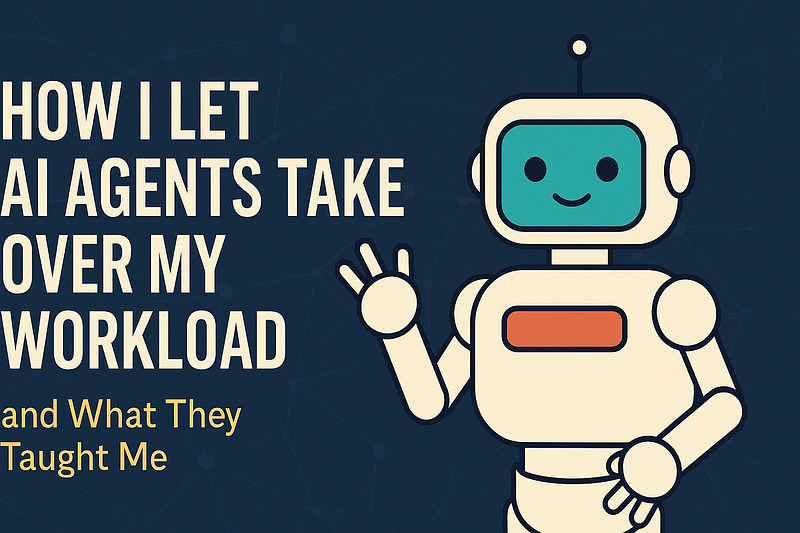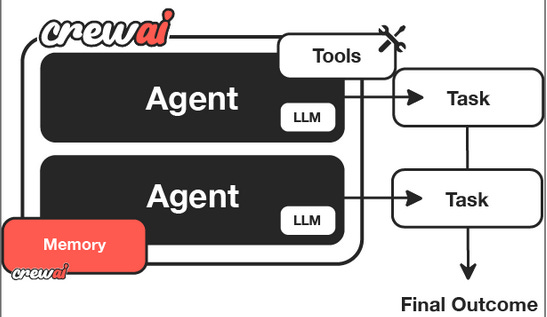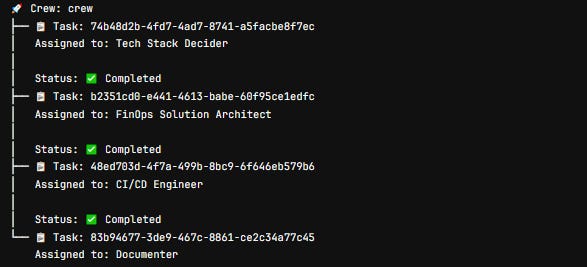I Tried Replacing Myself with AI Agents - Here's What Actually Happened
Lessons from building my first automated crew using CrewAI to handle real corporate tasks.
Recently, I started exploring the CrewAI framework, and like many of you, I enjoy learning by watching an introduction video and getting my hands dirty with a small personal project — while also diving into the official documentation.
So, I asked myself: What use case can I solve in my first project using CrewAI? Then it hit me… What if I let AI agents handle part of my corporate work? That’s exactly what I did — and that’s what I’m about to share with you. I’ll walk you through how I built it, what I learned, and how CrewAI works (just the basics you need to start building AI agents with CrewAI).
Are we ready??? I’m hoping to hear a big “YESS!!!!”
Now, a bit about the part of my work I decided to automate with AI agents. I’m currently a Cloud Engineer, responsible for most of the FinOps automation using GitLab CI/CD, Python, Shell scripting, and Terraform. The automation use cases I handle range from simple tasks — like sending automated emails to extract cloud data — to complex projects, such as automating updates for 400+ GCP project-level labels. That specific project would’ve taken about a month to complete manually, but automation cut it down to just 15 minutes.
How I Automated 350+ GCP Project Label Updates in 15 Minutes (Down from 1 Month!)
So, you’ve got a glimpse of my expertise — I focus mainly on automation to enhance platforms like GCP, AWS, or Azure.
Before diving into how I built my AI agent crew, let me quickly explain the basic workings of the CrewAI framework, so you can follow along more easily. It’s actually quite simple. Once you understand the core concepts, the rest — even the more complex parts — can be figured out with the help of the official documentation. It’s not as difficult as it might seem at first.
What is CrewAI framework and How it works?
You can simply Google the definition of the CrewAI framework and you’ll get the gist. But in short: it’s a Python framework that makes it easy to build multiple agents and automate tasks using LLM models.
How It Works
There are four core concepts you need to understand:
Agents (
agents.yaml)Tasks (
tasks.yaml)Crew (
crew.py)Main Function (
main.py)
Here’s how the flow works:
Agents and tasks are bound to each other. When you define an agent, you also define the task that agent is responsible for.
In agents.yaml, you define the personas your use case needs—like a researcher, analyst, or developer. For each agent, there are three mandatory attributes:
rolegoalbackstory
Once your agents are defined, move on to tasks.yaml. Here, you assign specific tasks to each agent. The mandatory attributes for every task are:
descriptionexpected_outputagent(the specific agent assigned to the task)
After you’ve created each agent-task pair based on your use case, it’s time to build a crew by orchestrating them in the desired sequence or structure. This happens in crew.py. Think of it as forming a team where all agents and tasks work together in sync.
Finally, in main.py, you call the functions or agent objects, passing any required input to trigger the automation process.
Sounds easy? That’s because it really is.
Sure, CrewAI has more advanced features — like tool integration and memory support for agents — but honestly, just follow the official documentation and you’ll figure it out. It felt surprisingly simple to me, and I’m confident it will for you too.
The main thing now! How I built and What I learned?
The Use Case I Set Out to Solve
As I mentioned earlier, I build a lot of automated pipelines using GitLab CI/CD. My typical process goes like this:
I analyze which tech stack is best suited for the specific use case.
I design a scalable and maintainable flow.
I build the CI/CD pipeline.
Finally, I document the entire pipeline development process.
So, when I first grasped the core concepts of CrewAI and was ready to start building this use case, here’s what my small brain thought (yes, I’m calling myself out!):
The agents I need to build are the “actors” in the real-world scenario — like a FinOps Manager who assigns tasks, and a FinOps Engineer (that’s me) who executes them.
So, I built two agents: finops_manager and finops_engineer. I then defined tasks for both agents based on their roles, and it all worked. The agents followed their instructions and produced results as expected.
Sounds great, right? Feels like a win?
But hear me out: this is a beginner mistake.
Yes, the agents ran and produced output — but the results were vague, inconsistent, and far from what you’d want in a production setting. It just didn’t feel “sharp” or purpose-built.
The Lesson: Your Steps, Not People, Are the Real Agents
The key mistake? I misunderstood who the real “actors” of the use case were.
The truth is, each step in your process is an agent, not necessarily a human role or job title.
Let’s go back and re-read the original workflow I follow. When broken down properly, these are your actual CrewAI agents:
Analyze tech stack →
tech_stack_deciderDesign the solution →
solution_architectBuild the pipeline →
ci_cd_engineerWrite documentation →
documenter
So, I restructured my agents accordingly. I created these four agents and assigned each a clear, focused task that aligned with one step of my real-world workflow. I also designed their tasks to pass output sequentially from one agent to the next — forming a tightly integrated automation chain.
The Outcome
Once everything was set, I built the crew function to orchestrate the full process—and oh boy, the result blew my mind.
The output was precise, relevant, and almost production-ready. All I had to do was make a few small adjustments to fit my preferences — and just like that, I had successfully automated a major part of my workflow using AI agents.
Wrapping Up:
If you want the full implementation, including the code, configuration files, and a detailed walkthrough — stay tuned! I’m currently working on a dedicated article that will break everything down step by step. It’ll include:
📄 Complete agent and task YAML files
🧠 Crew setup logic with explanations
🛠️ Best practices I learned along the way
🧪 Sample outputs and how to tweak them
🔧 Tips for debugging and refining your agents
🧰 How to integrate tools and memory into your agents for advanced workflows
So, don’t forget to follow me and subscribe to stay updated — especially if you’re someone who’s excited about automating real-world tasks with AI agents. The next article is going to be a hands-on deep dive, and I promise, you won’t want to miss it.
Get Free AI Guides here: https://codewarepam.gumroad.com/
🚀 Let’s Work Together!
If you’re building automation-heavy systems or looking to integrate AI agents into your DevOps or FinOps workflows — I’m open to freelance gigs, consulting, and full-time roles (remote-friendly). Whether you’re a startup needing rapid prototypes or an enterprise looking to scale automation, let’s connect!
📧 Reach out on LinkedIn or shoot me a DM — let’s build something great.
Connect: LinkedIn | Gumroad Shop | Medium | GitHub






